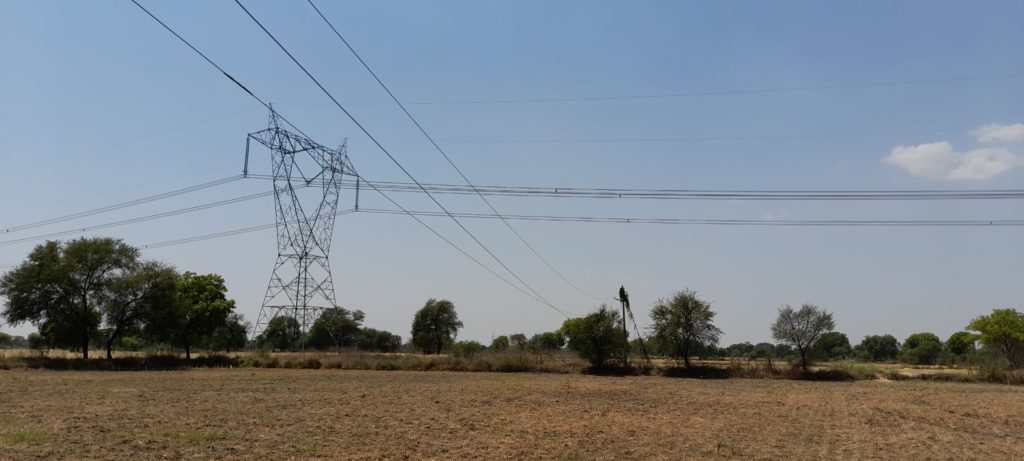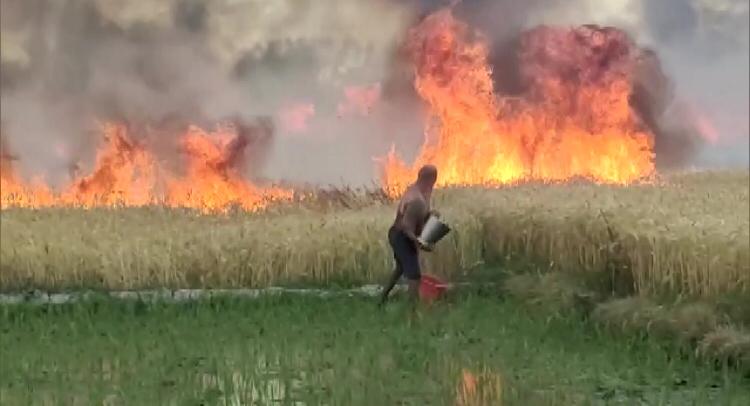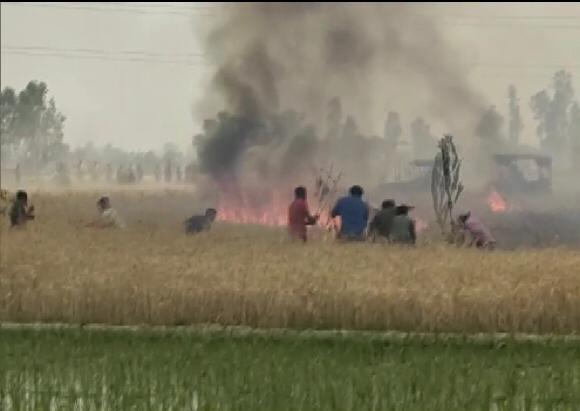In the line of fire, thousands of hectares of standing crops
Every year, fields of ready-to-harvest crops in Madhya Pradesh go up in flames as inadequate maintenance causes devastating electric fires, say the farmers. Only four months into the year, Satna district alone has reported 241 fires.


Every year farmers lose standing crops to farm fires caused due to low hanging power cables. Pic: Gaon Connection (Pic for representational purpose only)
Satna, Madhya Pradesh
When his acre of standing wheat crop went up in flames last month on March 31, Bedilal Ahirwar of Chilaud village reportedly consumed pesticide. A couple of days later, he breathed his last. Pappu Ahirwar, his family member, said that a short circuit in the wires hanging over Bedilal’s field led to a fire that reduced his entire wheat crop to ashes.
Bedilal was not the only farmer who lost months of toil and investment in his farmland to a short circuit in a low hanging live electricity wire. This year, several districts in Madhya Pradesh reported fires that swept through hectares of crops still standing in the field.
Take the case of the state’s Satna district. The year is only four months old and already 241 cases of field fires have been reported in the district, an official from the relief branch of the Satna collectorate told Gaon Connection on condition of anonymity. The relief branch records data on disasters in the district, and the compensations made out thereof.
Last year, there were 891 cases of crops burning down due to electrical fires and 68 farmers received some compensation. In 2019, there were 854 cases of crops catching fire, and 105 farmers were compensated, the official informed Gaon Connection.
Also Read: Fields on fire: 1,500 fire incidents a day in Uttar Pradesh; heavy damage to standing wheat crop
“Till date the electricity department has taken no real measures to prevent the fires,” Premlal Vishwakarma, a 55-year-old farmer from Chachai village in Rewa district, told Gaon Connection. “Just a few days ago, Bhaiyya Lal, a fellow farmer lost not just his crop in a fire, he also lost his home and the shack he had built to place his pump in,” he added.

On its part, the electricity department insists that it has been doing regular maintenance. “We do a maintenance check of the electric wires twice each year, in April/May before the rains, and in October, after the rains,” VKS Parihar, state secretary, Madhya Pradesh Engineers’ Union, told Gaon Connection.
There are complaints, claims, counter claims and finger pointing between the farmers and the electricity department, while field after field continues to burn.
Incideniary matters
According to the farmers, power cables go over the fields, tied to pillars that are 20-30 metres apart. Over time, these cables sag and when it gets windy the lines collide with each other leading to sparking. When live electricity wires break up in stormy weather and fall to the ground, they can start fires.
“This is one of the main reasons why the fires happen. But all that the electricity department is interested in is collecting the electricity bills,” said Vishwakarma bitterly.
“I tried to lodge a complaint several times with the department that the electric lines were just three to four feet above my field. But each time I was shooed away,” Babboo Kushwaha of Dehli village in district Rewa told Gaon Connection. “Instead of putting out the fires, they demand we pay our electricity bills,” he added.

Farmers accuse the electricity department of dragging its feet over maintenance. “Four years ago, nearly 30 acres of land were burned down because of the faulty, sagging, wires that kept colliding with each other,” Jaisingh Parihar, a farmer from Bhatgawan village in Satna district, told Gaon Connection. Still, the electricity department took no action to set things right, he alleged.
The farmers claim that they themselves took makeshift measures to separate the wires. They used strips of bamboo to separate the wires so they wouldn’t come into contact with each other. “It is still the same way four years on,” said Jaisingh pointing to the dangerously sagging wires running overhead his eight-acre land.
Similar worries are echoed by Bal Govind from Masnaha village: “The only maintenance that is carried out by the electricity department is lopping off the branches of the trees.”
Also Read: Stubble Trouble: Air quality dips in Delhi; spotlight shifts to farmers in Punjab and Haryana
But, Parihar, the state secretary of Madhya Pradesh Engineers’ Union, informed Gaon Connection that during maintenance the tension of the wires and the condition of the insulators are checked and if required even replaced. In the case of trees obstructing the wires, that was taken care of too, by pruning or cutting them. He acknowledged that fires could start due to sparking or short circuits, D.O (Drop Out Fuses) fuses blowing up, or by the swaying wires getting entangled with each other.

“We don’t deny that fire can be caused by electricity,” PK Misra, superintendent engineer, Madhya Pradesh Poorva Kshetra Vidyut Vitaran Company, in district Seoni, told Gaon Connection. But, according to him, the farmers have been warned many times to cut the standing crops below the transformer and electricity lines and then water the area, but they never listen, he said.
Compensation not enough
Whereas a number of farmers annually lose their ready-to-harvest crop, they claim the compensation offered to them is a pittance. “Last year my acre of field caught fire and I lost my entire crop. I received a compensation of three thousand rupees only. We farmers demand that the state government offer us a higher compensation,” Siyasharan Saket, a farmer from Ramnagar in Satna, told Gaon Connection.
According to Ashish Tiwari, patwari of Ramnagar tehsil in Satna district, compensation amounts vary depending on the land. “Crop loss on irrigated land, which is less than two hectares, is thirty thousands rupees per hectare. More than two hectares land receives a compensation of twenty seven thousand per hectare,” he informed Gaon Connection. “Similarly, for unirrigated land below two hectares, the compensation is fixed at sixteen thousand rupees per hectare. Farmers owning more than two hectares of unirrigated land receive fourteen thousand rupees per hectare compensation,” he added.
1,500 fires a day in UP
Not just in Madhya Pradesh, but across the country, crop damage due to fires is rampant. According to the Uttar Pradesh fire service control room in Lucknow, March to June are the peak months when 1,500 fires are reported each day across the state. Many of them are crop fires.

“Most of the fire incidents are reported during the westerly winds in the rural areas. We have written to the electricity department to come up with a measure so that wires don’t break during strong winds. Also, people need to be made aware as well,” Raj Prakash Rai, chief fire officer, Barabanki had told Gaon Connection earlier this month.
Meanwhile, records from the fire department in Sitapur district of Uttar Pradesh, reveal that there were 497 incidents of fire in 2019; the following year, there were 392; and this year, as of April 9, there have already been 106 fire incidents. While there is no separate data on crop fires, the department records indicate the inadequacy of fire-fighting infrastructure.
While the Sitapur district’s fire department is entitled to six big water tenders (with a capacity of up to 5,000 litres), it has only three. From the sanctioned six smaller water tenders with a capacity of 2000 to 2500 litres, the department has four with it. Similarly while it should have six water tenders with high pressure pumps, what is available is only one.
Meanwhile, with the blistering summer months already here, and along with them, pre-monsoon season storms and strong winds, the dry-as-tinder, ready-to-be-harvested crops get more and more vulnerable to fires. “It takes just one tiny spark to consume our months of hard labour… all in the space of a few minutes,” said Gobind Lal as he surveyed his standing crops, wondering how safe they were.
With inputs from Mohit Shukla in Sitapur, Uttar Pradesh.

